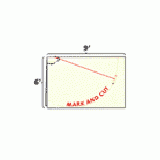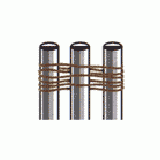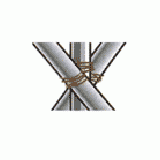Total Time Needed: Afternoon Or Evening
Just like the traditional Native American tepee that inspired it, this backyard shelter can be assembled and dismantled in a jiffy.
Materials
- 9- x 12-foot canvas tarp or drop cloth
- Measuring tape
- Colored marker
- Scissors
- White cotton rope
- Ten 8-foot-long white PVC pipes, 3/4 inch in diameter
- Hacksaw (optional)
- 2 chopsticks or similar strips of wood
Instructions
1. Fold the tarp in half so that it forms a 9- x 6-foot rectangle.
2. Measure in 1 foot along the fold and mark the spot.
3. Cut a 6-foot length of rope. Have your child hold one end of the rope at the marked spot while you tie the opposite end around the colored marker.
4. Step away from your child until the line is taut and move the rope in an arc, marking a line on the canvas as you go.
5. Cut the tarp along the line and then cut out a 12- x 6-inch rectangle to the left of the marked spot at the top of the tepee.
6. Loosely tie together three of the PVC pipes two feet down from the tops with a piece of rope, then stand them up like a tripod.
7. Lean the remaining poles against the tripod so that they are evenly spaced.
8. Drape the cut canvas around the tepee frame, overlapping the top a bit. Make 2 sets of holes through both layers of the overlapped portion and thread the chopsticks through them to hold the canvas in place.
9. To secure the lower edge of the canvas to the frame, first snip a small hole about 1 inch from one of the tarp's bottom corners.
10. Loop a short length of rope through the hole, as shown, and tie the ends around the base of one pole (this pole will become part of the doorway).
11. Gently stretch the canvas around the PVC frame so that the canvas extends past the first pole to create a door flap.
12. Snip a small hole near the lower edge of the canvas where it falls on the remaining poles and tie it in place using the same method as before.
Crafts











